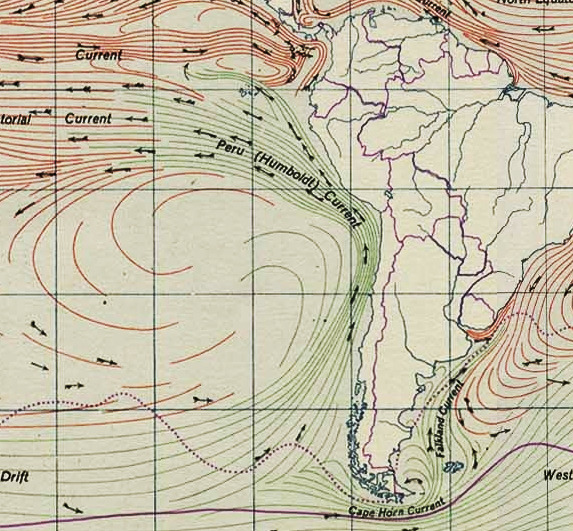Humboldt Current
THE HUMBOLDT CURRENT, also known as the Peru Current, is an ocean current that flows along the western coast of South America, affecting the water and air temperatures of coastal CHILE and PERU. It is one of the largest ocean currents in the world, bringing cold water north from the South PACIFIC for thousands of kilometers (from 40 degrees S to 5 degrees S) before it dissipates in the warmer waters around the equator.
The Humboldt Current, named for Alexander von Humboldt, the German naturalist and geographer who devoted much of his work to South America, is small and sluggish in comparison to the GULF STREAM and works in the opposite fashion, bringing colder water north from ANTARCTICA and lowering temperatures along the Pacific coast by 45 to 47 degress F (7 to 8 degrees C).

Its chilled air carries less moisture, thus helping to create the world's driest desert in Chile's Atacama Desert. The northern end of the current flows past the Galapagos Islands (off the coast of ECUADOR). Cooler water and air temperatures have affected the wildlife of the Galapagos, allowing cold-water species such as penguins and fur seals to thrive as far north as the equator.
The Humboldt Current creates one of the largest and most productive marine ecosystems in the world. Cold waters with low salinity and high levels of nutrients are brought to the surface through upwelling, providing sustenance to fish and marine mammals. The coasts of Peru and Chile are therefore one of the largest fisheries in the world, with approximately 18 to 20 percent of the world's fish catch. Dominant species include sardines, anchovies, and mackerel. Upwelling occurs off the shores of Peru year-round, sometimes as far as 620 mi (1,000 km) into the Pacific Ocean, but only during the summer off the coasts of Chile.
The current is periodically disrupted by climatic changes known as EL NINO, referred to by meteorologists and oceanographers as El Nino Southern Oscillation (ENSO) events. El Nino usually consists of winds blowing perpendicular to the current, coming from the west across the Pacific, bringing warmer waters with lower nutrients and unusually heavy rains. The causes of this are uncertain, potentially related to changes in circumpolar currents, which may in turn be caused by effects of global warming on the poles. ENSO events can seriously disrupt the local climate and the productivity of the region's fisheries.
Human activity, however, is also a cause itself in the disruption of the area's rich biodiversity. Overfishing threatens the marine mammals and sea birds that rely on fish for their basic diet. Such species include sea otters, sea lions, large sea birds, and whales. Pollution is also a problem in the region, caused by sewage and industrial waste, particularly related to petroleum and copper exploitation.
Both Peru and Chile are increasing levels of development in tourism and urbanization along their lengthy coasts, but they have also joined together in regional cooperation for managing the Humboldt Current ecosystem. International groups such as UNIDO (United Nations Industrial Development Organization) and GIWA (Global International Waters Assessment) are working to develop comprehensive sustainable aquaculture management proposals.